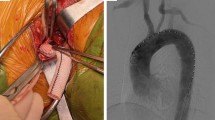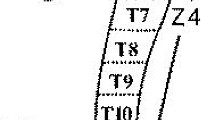Abstract
Atherosclerotic subclavian artery stenosis (SAS) accompanied with other craniocervical artery stenosis (OCAS) is not uncommon in practice. We sought to investigate the safety and efficacy of endovascular stenting for SAS in patients with OCAS. Between January 2004 and February 2012, 71 consecutive atherosclerotic SAS patients who underwent primary stenting in our medical center were included. The enrolled patients were divided into combined-SAS group (n = 51) and solitary-SAS group (n = 20) depending on the presence or absence of OCAS. Data of demographics, procedure, and the followed-up were retrieved and analyzed. The technical success rate was 95.8 %; the clinical success rate was 90.1 %. There was no catheter-related major stroke or death. The immediate outcomes had no statistical difference between groups. During a mean of 27 ± 20 months (range 2–88 months) followed-up, 7(10.3 %) restenosis and 12(17.6 %) clinical events were identified. The primary patency rate was 95.3, 84.9 and 84.9 % at 12, 24 months, and final followed-up respectively, which had no statistical difference between groups (odds ratio (OR), 2.60; 95 % confidence interval (CI), 0.54–12.53; P = 0.232). The overall clinical event-free survival rate was 93.5, 86.2 and 54.6 %, respectively, where the result of combined-SAS group was inferior to that of the solitary-SAS group (OR, 3.34; 95 % CI, 1.02–11.00; P = 0.047). Endovascular stenting was safe and feasible for atherosclerotic SAS in patients with OCAS, although the combined OCAS may have a significant influence on the long-term outcome. Further studies are warrant to investigate the effects of revascularization for multiple craniocervical artery stenoses on the cerebral hemodynamics and long-term outcomes.


Similar content being viewed by others
References
Brountzos EN, Malagari K, Kelekis DA (2006) Endovascular treatment of occlusive lesions of the subclavian and innominate arteries. Cardiovasc Intervent Radiol 29:503–510
Brountzos EN, Petersen B, Binkert C, Panagiotou I, Kaufman JA (2004) Primary stenting of subclavian and innominate artery occlusive disease: a single center’s experience. Cardiovasc Intervent Radiol 27:616–623
Fields WS, Lemak NA (1972) Joint study of extracranial arterial occlusion. VII. Subclavian steal—a review of 168 cases. JAMA 222:1139–1143
Wholey MH, Wholey MH (2004) The supraaortic and vertebral endovascular interventions. Tech Vasc Interv Radiol 7:215–225
Criado FJ, Twena M (1996) Techniques for endovascular recanalization of supra-aortic trunks. J Endovasc Surg 3:405–413
Mathias KD, Luth I, Haarmann P (1993) Percutaneous transluminal angioplasty of proximal subclavian artery occlusions. Cardiovasc Intervent Radiol 16:214–218
Sixt S, Rastan A, Schwarzwalder U et al (2009) Results after balloon angioplasty or stenting of atherosclerotic subclavian artery obstruction. Catheter Cardiovasc Interv 73:395–403
Patel SN, White CJ, Collins TJ et al (2008) Catheter-based treatment of the subclavian and innominate arteries. Catheter Cardiovasc Interv 71:963–968
AbuRahma AF, Bates MC, Stone PA et al (2007) Angioplasty and stenting versus carotid-subclavian bypass for the treatment of isolated subclavian artery disease. J Endovasc Ther 14:698–704
Babic S, Sagic D, Radak D et al (2012) Initial and long-term results of endovascular therapy for chronic total occlusion of the subclavian artery. Cardiovasc Intervent Radiol 35:255–262
Miyakoshi A, Hatano T, Tsukahara T, Murakami M, Arai D, Yamaguchi S (2012) Percutaneous transluminal angioplasty for atherosclerotic stenosis of the subclavian or innominate artery: angiographic and clinical outcomes in 36 patients. Neurosurg Rev 35:121–125, discussion 125–126
Berger L, Bouziane Z, Felisaz A, Coffin O, Dugue A, Maiza D (2011) Long-term results of 81 prevertebral subclavian artery angioplasties: a 26-year experience. Ann Vasc Surg 25:1043–1049
Liu X, Xu G, Wu W, Zhang R, Yin Q, Zhu W (2006) Subtypes and one-year survival of first-ever stroke in Chinese patients: the Nanjing Stroke Registry. Cerebrovasc Dis 22:130–136
Timaran CH, McKinsey JF, Schneider PA, Littooy F (2011) Reporting standards for carotid interventions from the Society for Vascular Surgery. J Vasc Surg 53:1679–1695
North American Symptomatic Carotid Endarterectomy Trial Collaborators (1991) Beneficial effect of carotid endarterectomy in symptomatic patients with high-grade carotid stenosis. N Engl J Med 325:445–453
Samuels OB, Joseph GJ, Lynn MJ, Smith HA, Chimowitz MI (2000) A standardized method for measuring intracranial arterial stenosis. AJNR Am J Neuroradiol 21:643–646
Lian X, Lin M, Zhu S et al (2011) Risk factors associated with haemodynamic depression during and after carotid artery stenting. J Clin Neurosci 18:1325–1328
Wang KQ, Wang ZG, Yang BZ et al (2010) Long-term results of endovascular therapy for proximal subclavian arterial obstructive lesions. Chin Med J (Engl) 123:45–50
Sixt S, Rastan A, Schwarzwalder U et al (2008) Long term outcome after balloon angioplasty and stenting of subclavian artery obstruction: a single centre experience. Vasa 37:174–182
Song L, Zhang J, Li J et al (2012) Endovascular stenting vs. extrathoracic surgical bypass for symptomatic subclavian steal syndrome. J Endovasc Ther 19:44–51
De Vries JP, Jager LC, Van den Berg JC et al (2005) Durability of percutaneous transluminal angioplasty for obstructive lesions of proximal subclavian artery: long-term results. J Vasc Surg 41:19–23
Huttl K, Nemes B, Simonffy A, Entz L, Berczi V (2002) Angioplasty of the innominate artery in 89 patients: experience over 19 years. Cardiovasc Intervent Radiol 25:109–114
Schillinger M, Haumer M, Schillinger S, Ahmadi R, Minar E (2001) Risk stratification for subclavian artery angioplasty: is there an increased rate of restenosis after stent implantation. J Endovasc Ther 8:550–557
Labropoulos N, Nandivada P, Bekelis K (2010) Prevalence and impact of the subclavian steal syndrome. Ann Surg 252:166–170
Bornstein NM, Norris JW (1986) Subclavian steal: a harmless haemodynamic phenomenon. Lancet 2:303–305
Valerio N, Rosset E, Ede B, Pasquier J, Branchereau A (2001) Compromised hemodynamics associated with multipedicular lesions of cerebral arteries. Ann Vasc Surg 15:219–226
Klijn CJ, Kappelle LJ (2010) Haemodynamic stroke: clinical features, prognosis, and management. Lancet Neurol 9:1008–1017
Klijn CJ, Kappelle LJ, van der Grond J et al (2001) Lack of evidence for a poor haemodynamic or metabolic state of the brain in patients with haemodynamic clinical features associated with carotid artery occlusion. Cerebrovasc Dis 12:99–107
Acknowledgments
This study was supported in part by Nature Science Foundation of China (NSFC 30870847 to Xinfeng Liu, NSFC 81000501 to Dezhi Liu) and Jiangsu Nature Science Foundation (BK 2010067 to Wusheng Zhu).
Conflicts of interest
We have no conflicts of interest.
Author information
Authors and Affiliations
Corresponding authors
Additional information
Yongkun Li and Qin Yin are contributed equally to this study.
Rights and permissions
About this article
Cite this article
Li, Y., Yin, Q., Zhu, W. et al. Endovascular stenting for atherosclerotic subclavian artery stenosis in patients with other craniocervical artery stenosis. J Thromb Thrombolysis 35, 107–114 (2013). https://doi.org/10.1007/s11239-012-0789-4
Published:
Issue Date:
DOI: https://doi.org/10.1007/s11239-012-0789-4




